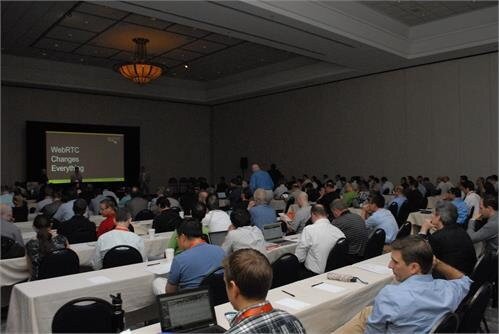It was a long long week. But a very interesting one.

Hands down, WebRTC Conference & Expo is the largest event of our tiny industry. Tiny because it felt like a tight knit of people, and there lies the problem – it is still in the VoIP domain and not in the web domain.
Someone asked me at the end of the first day what was the best part of the conference – I assume he tried to get my view on the demos shown. My answer? It wasn’t anything specific – it was the people there. I had the opportunity to meet so many of you – people I’ve been interacting here in my blog and elsewhere on the internet – in person. Video calling, and WebRTC for that matter, may provide new means of communications but they will never really replace that magical time of hanging out with someone. Of sitting around a table for dinner with people and enjoying yourself.
I assume you want some highlights from the show, so here are mine:
- Around 700 attendees, which means we’re in an exponential growth of people and interests around WebRTC
- Around 35 demos – most polished and ready for use by anyone – next time someone tells you WebRTC isn’t ready for primetime, you can say to him he is clueless
- There were real products with real end customers using it already, which to me is a validation of the need
- No interesting gaming companies. Yet
- Very little innovative use of the data channel. I hope to start seeing it in one of the next events
- Some booth vendors had only Powerpoint to show (these were the incumbents), which was sad, considering a lot of startup companies came out with running services that have paying customers on them already
- There are some super smart people working in this domain, and it was a joy to work to them
If you are looking for more, then the WebRTC World website has that coverage. To top it off, Andy Abramson has done a great job of aggregating the news around the show on a daily basis (Tuesday A, Tuesday B, Wednesday, Thursday).
And if you are looking for the session I had with Ken Workun from Genband about WebRTC Disruption, then here’s the slide deck:
[slideshare id=23587371&doc=g-1webrtcdisruptionsv2-f-130627143004-phpapp02]
–
Have a great weekend, and a safe travel back home for those who were in Atlanta.

Perhaps its from my many years of working with SBCs, but on your slide 3, for SIP NAT traversal, I would also include Hosted NAT traversal. HNAT is the predominant method used by most SBC-based VoIP deployments and was required before there was broad ICE/STUN/TURN support in many clients and persists in most of those deployments today.
Disclaimer: I am an employee of Oracle. Opinions are my own and not those of Oracle.
My third slide there is about setting the stage – looking for disruption from the point of view of the technical spec of WebRTC versus SIP makes no sense at all. It does practically the same (sans signaling).